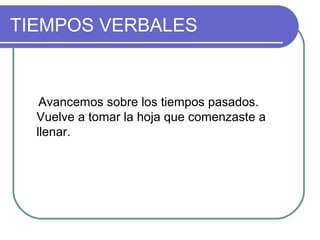
Viviana valenti -tiempos verbales-U3-past simple-cont
- 1. TIEMPOS VERBALES Avancemos sobre los tiempos pasados. Vuelve a tomar la hoja que comenzaste a llenar.
- 2. TIEMPOS VERBALES PRESENT PAST FUTURE ______________ 6 0 7 líneas …………………….. …………………….. …………………… …………………….. …………………….. …………………… …………………….. …………………….. …………………… …………………….. …………………….. _________________ IDEM EN EL RESTO __________________ FORMULA CONCEPTO CONCEPTO CONCEPTO FORMULA FORMULA
- 3. A continuación trabajaremos el siguiente cuadrante. Verás en verde los cuadrantes que fueron trabajados anteriormente.
- 5. SIMPLE PAST Volvamos al ejemplo de la válvula The valve opened the path of gases. The valve opened.
- 6. TIEMPOS VERBALES PRESENT PAST SIMPLE The valve opened the path of gases The valve opened CONTINUOUS CONTINUOUSCONTINUIDAD To be + v ing
- 7. SIMPLE PAST Estas oraciones están en PASADO SIMPLE (un solo verbo) y el concepto detrás de toda la hilera de SIMPLES, será priorizar los HECHOS mismos, en este caso un hecho ocurrido en un momento puntual en el pasado. The valve opened the path or gases. The valve opened.
- 9. SIMPLE TENSES La fórmula para los simples se mantendrá. La única variación será el agregado al verbo principal para indicar tiempo pasado. Procedamos a completarla: VERB -0 -S -ed
- 10. SIMPLE TENSES SIMPLE HECHOS VERB + [-0 / -S / -ED]
- 11. TIEMPOS VERBALES PRESENT PAST SIMPLE The valve opened the path of gases The valve opened CONTINUOUS CONTINUOUSCONTINUIDAD To be + v ing V [-0 / -S / -ED] HECHOS
- 12. SIMPLE PAST Recordemos las reglas y apliquémolas: 1. NOT – no va suelto 2. 1 verbo – AYUDA D 3. Question – (verbo, persona, verbo)
- 13. SIMPLE PAST ¿Cómo se formará la negación si tenemos un solo verbo? (recurriremos a la regla 2 en busca de ayuda) Ya que sería imposible pegar el not al verbo open (openn’t) The valve didn’t open the path or gases. The valve didn’t open. (notar cómo al usar did desaparece la –ed)
- 14. SIMPLE PAST ¿Cómo se formará la pregunta? De igual modo recurriendo a la regla 2 por ayuda. Did the valve open the path or gases? Did the valve open?
- 15. SIMPLE PAST Traduzcamos la oraciones
- 16. SIMPLE PAST The valve opened the path La válvula abrió el paso didn’t open no abrió The valves opened the path Las válvulas abrieron el paso didn´t open no abrieron The valve opened La válvula se abrió didn’t open no se abrió The valves opened Las válvulas se abrieron didn’t open no se abrieron
- 17. Pasemos al siguiente recuadro para trabajar con los ejemplos
- 19. PAST CONTINUOUS Veamos los nuevos ejemplos The valve was opening the path of gases The valves were opening the path of gases The valve was opening The valves were opening
- 20. PAST CONTINUOUS El concepto detrás de este tiempo también será el de CONTINUIDAD, como vimos para el Presente continuo. Sólo que dicha continuidad se dará en un tiempo pasado.
- 21. PAST CONTINUOUS To be + V + -ING (was – were) La fórmula permanecerá igual, solo que el verbo TO BE tomará la forma del pasado
- 22. PAST CONTINUOUS CONTINUOUS CONTINUIDAD To BE + V ing
- 23. TIEMPOS VERBALES PRESENT PAST SIMPLE CONTINUOUS The valve was opening the path of gases The valves were opening …… CONTINUIDAD To be + v ing V [-0 / -S / -ED] HECHOS
- 24. PAST CONTINUOUS ¿Y la negación? ¿Y la pregunta? Ningún problema porque estamos ante la presencia de dos verbos y no necesitamos ayuda de ningún tipo.
- 25. PAST CONTINUOUS Veamos los nuevos ejemplos The valve was opening the path … La válvula estaba abriendo el paso de…. wasn’t opening no estaba abriendo Was the valve opening. …? ¿Estaba la válvula abriendo …?
- 26. PAST CONTINUOUS Veamos los nuevos ejemplos The valves were opening the path … Las válvulas estaban abriendo el paso de…. weren’t opening no estaban abriendo Were the valves opening. …? ¿Estaban la válvulas abriendo …?
- 27. PAST CONTINUOUS Reduzcamos las oraciones, haciéndolas reflexivas The valve was opening wasn’t opening La válvula se estaba abriendo no se estaba abriendo The valves were weren’t opening Las válvulas se estaban abriendo no se estaban abriendo
- 28. Terminemos simplificando lo visto hasta el momento.
- 29. TIEMPOS VERBALES PRESENT PAST FUTURE simple 1 Verb contin. To be + ing